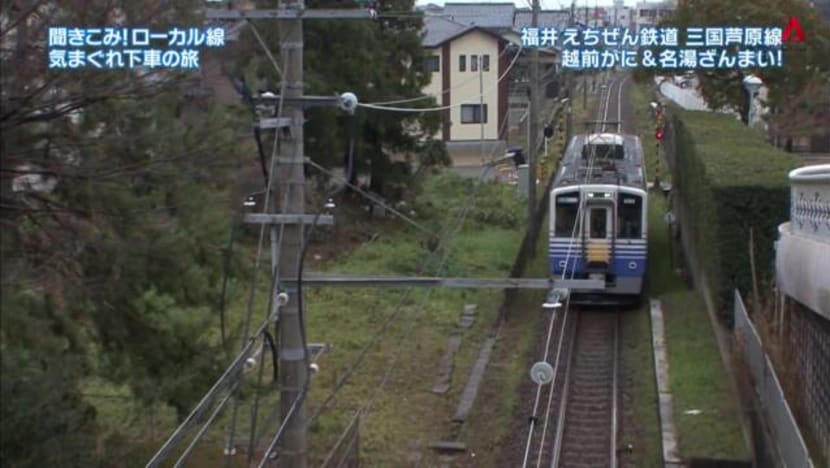Road Trip On Yamagata Tetsudo Flower-Nagai Line - Part 2
Highlights include a shrine dedicated to Emperor Keitai, an old house which is a registered national tangible cultural property and a luxurious meal featuring Echizen snow crabs, a famous delicacy.

We continue our two-day journey on Echizen Railway’s Mikuni Awara Line in Fukui Prefecture We advanced to Awara-Yunomachi Station on the first day. We try booking rooms at Matsuya Sensen at Awara Onsen but it is full, so we go to Grandia Housen, the other place which was recommended to us. With more than 100 rooms, it is one of the largest inns in Fukui Prefecture. It has rooms available but as it is quite late, dinner is not provided. However, one of the staff, Mr Aoki, suggests we eat at Kappo Katsu. It is known for its seafood dishes using fish caught from Mikuni Port.
We relax in the inn’s private hot spring baths. We then walk to Kappo Katsu, which is 10 minutes away from Grandia Housen. It serves delicacies from the Sea of Japan. We feast on sashimi, squid, gasa shrimp and female snow crabs which are known as Seiko or Kobako crabs. The restaurant’s other dishes include vinegared oysters and deep-fried flounder.
The next morning, the inn prepares a buffet-style breakfast of more than 30 dishes featuring the inn’s specialities. They include assorted delicacies from the sea and mountains of Fukui Prefecture. Examples are simmered Kamisyo taro and pickled plums. After breakfast, we take the 9.20am train from Awara-Yunomachi Station and go to the neighbouring Mizui Station. We reach in less than five minutes. The locals tell us this area used to be full of fields with common reed, which is used to make bamboo blinds are other products. We also find out that Mikuni has a long history and used to be a fishermen’s town. There are also many temples, one of which is the Mikuni Shrine near the next station, Mikuni-Jinja.
We then take the 9.50am train and reach Mikuni-Jinja in five minutes. After asking a local for directions, we manage to find Mikuni Shrine. It is a historic shrine dedicated to Emperor Keitai. Every May, the Mikuni Festival is held. It is one of the three largest festivals in the Hokuriku region. We ask a resident about recommended spots near the neighbouring stop, Mikuni Station. The person mentions the Old Kishina House and a building which used to be the Morita Bank. We take the 11.25am train to Mikuni Station, five minutes away. There are many charming buildings in this area.
On our way to the Old Kishina House, we drop by a place selling Mikuni Burger. What makes it unique is that it has pickled Japanese shallots from Mikuni inside, which go well with the beef from Fukui Prefecture. After trying the burger, we continue walking to the Old Kishina House. We are given a tour of the house, which belonged to the Kishina family, who were wealthy timber merchants. It was built at the end of the Edo period and is now a registered national tangible cultural property. Our next stop is the former head office of the Morita Bank. The bank was founded in the Meiji era by the Morita family, who were shipping wholesalers.
After this, we head to the terminal, Mikuni-Minato Station on the 1.25pm train. It is just two minutes away. There are crab and shrimp restaurants all over this town. A local here recommends Takesho, which serves the famous Echizen crabs. After a 15-minute walk, we realise that we have inadvertently walked to Mikuni Station, which we just came from by train. We ask for directions and end up reaching the restaurant at 2.30pm, about an hour after leaving Mikuni-Minato Station. It turns out that it was closer to Mikuni Station. Mikuni's fishing port is the home of Echizen crabs. Some of the crabs cost about 35,000 yen per piece. Those weighing more than 1.1kg are offered to the Imperial Family. Takesho’s popular meals are named after the ships that do trawl fishing to catch crabs. We end up ordering the full course Chitosemaru meal, which costs nearly 20,000 yen. It includes Echizen crab sashimi, grilled crab, female snow crab and crab porridge.
We later speak to another local who tells us about Nishisaka. Established in 1921, it sells Mikuni’s speciality, saka manju. It was introduced by boatmen during the Kitamaebune period. It was valued by wealthy merchants as they believed it brings good luck. The character “Cho” is printed on the manju and is taken from the founder's name Chojiro.
Tips:
1) Recommended attractions in Mikuni are the Old Kishina House and the former head office of Morita Bank
2) Echizen crabs are a must-try delicacy of Fukui Prefecture












